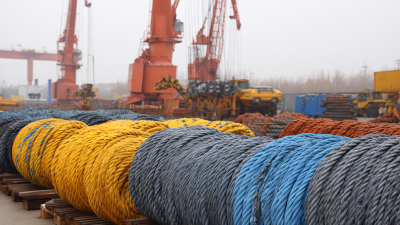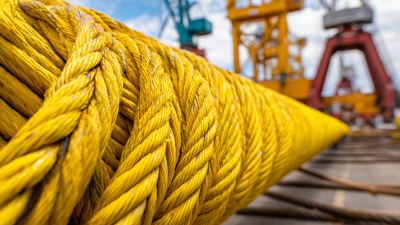Unlocking the Strength: Understanding the Benefits of High Tensile Crane Rope in Modern Industries
In the realm of modern industries, the significance of using High Tensile Crane Rope cannot be overstated. As industries evolve and the demand for efficient lifting solutions increases, the properties of these advanced ropes bridge the gap between safety and performance. According to a report by the International Association of Lifting and Handling Equipment (IALHE), the global lifting equipment market is projected to reach $27 billion by 2025, underscoring the vital role that high-performance materials like High Tensile Crane Rope play in sustaining this growth. Their superior strength-to-weight ratio enables cranes to handle heavier loads while maintaining operational efficiency, minimizing downtime.

Furthermore, a recent study by the Material Handling Industry of America revealed that the adoption of High Tensile Crane Rope could reduce the risk of workplace accidents by up to 30%. This statistic highlights the importance of incorporating high-quality materials into lifting operations, ensuring not only the safety of the workforce but also enhancing the overall productivity of industries. As we delve deeper into the benefits of High Tensile Crane Rope, we will explore how these innovations are shaping the future of lifting operations across various sectors, providing practical tips and insights for industry leaders.
Benefits of High Tensile Crane Rope in Heavy Lifting Operations
High tensile crane ropes play a crucial role in heavy lifting operations across various modern industries. These ropes, known for their superior strength and durability, outperform traditional materials in lifting applications. As the global lifting accessories market is projected to reach USD 973.8 million by 2035, the demand for robust and reliable materials like high tensile ropes is on the rise, reflecting their critical role in enhancing operational efficiency.
When selecting the appropriate rope for heavy lifting, it’s essential to weigh the benefits of steel wire ropes against synthetic alternatives. Steel wire ropes provide greater crush resistance, making them ideal for winching or lifting heavy equipment. In contrast, the synthetic rope market is expected to grow significantly, from USD 1.77 billion in 2025 to USD 3.04 billion by 2033, indicating a shift in preferences due to lighter weights and ease of handling.
**Tips:** Always assess the specific lifting needs of your operations, considering factors like weight, environment, and required flexibility. Additionally, regularly inspect lifting equipment for wear and tear to ensure safety and optimal performance. Finally, ensure proper training for operators on the correct usage of high tensile crane ropes to maximize their effectiveness.
Comparative Analysis: High Tensile Crane Rope vs. Traditional Rope
High tensile crane ropes have emerged as a superior alternative to traditional ropes in modern industries, providing enhanced strength and durability that are crucial for heavy lifting and demanding applications. Unlike conventional ropes, which often suffer from limitations in load-bearing capacity and lifespan, high tensile ropes are engineered from advanced materials that significantly improve performance. Their ability to endure high levels of stress without deformation makes them ideal for cranes operating in various industrial environments, where safety and efficiency are paramount.
A comparative analysis reveals that high tensile rope outperforms traditional rope in several key aspects. For instance, high tensile ropes exhibit less elongation under load, resulting in more precise control during lifting operations. Additionally, improvements in surface treatment technologies, such as the application of water jets for cleaning grease and enhancing adhesion properties, have further optimized the performance of high tensile ropes, particularly those made of galvanized or stainless steel. This not only boosts the mechanical properties of the ropes but also extends their service life, making them a wise investment for industries reliant on heavy lifting solutions.
Durability and Maintenance Advantages of High Tensile Crane Rope
High tensile crane rope has become a critical component in various industrial applications due to its impressive durability and maintenance advantages. Unlike traditional ropes, high tensile options resist wear and tear better, ensuring longevity even under extreme conditions. This resilience translates to less frequent replacements, allowing businesses to save on costs associated with purchasing and installing new ropes. Additionally, high tensile crane ropes are designed to withstand high loads, which makes them ideal for heavy lifting tasks in construction, manufacturing, and shipping industries.
Tip 1: Regular inspections of high tensile crane ropes can help detect early signs of wear, which can further prolong their lifespan. It's important to address any issues promptly to maintain the effectiveness and safety of your operations.
Another significant advantage of high tensile crane rope is its low maintenance requirements. These ropes typically require less frequent lubrication and cleaning compared to their synthetic counterparts, reducing overall maintenance time and effort. The smoother surface of high tensile wires also minimizes friction during use, which contributes to their extended operational lifespan.
Tip 2: Implement a planned maintenance schedule that includes routine checks and cleaning of your crane ropes to maximize their durability and functionality. This proactive approach will ensure that you can avoid costly downtimes caused by unexpected rope failures.
Applications of High Tensile Crane Rope Across Various Industries
High tensile crane ropes have become indispensable in various industries, offering significant advantages in strength, durability, and flexibility. These ropes are engineered to withstand heavy loads and extreme conditions, making them ideal for applications in sectors such as construction, shipping, and manufacturing. The global market for mooring ropes, which includes high tensile crane ropes, is projected to reach a valuation of $1.39 billion by 2024, with expectations to grow to $1.46 billion by 2025, and further increase to $2.17 billion by 2032. This rapid growth highlights the increasing demand for reliable lifting equipment across different industrial applications.
In construction, for example, high tensile crane ropes play a critical role in facilitating the safe and efficient movement of materials on job sites. Their superior tensile strength allows for the lifting of heavier weights compared to traditional ropes, reducing the number of ropes needed and enhancing overall safety. Similarly, in the shipping industry, these ropes are essential for securing cargo and ensuring safe mooring during loading and unloading processes. As industries continue to evolve, the adoption of high tensile crane ropes is expected to expand, driven by the need for greater efficiency and safety in material handling operations.
Safety Enhancements with the Use of High Tensile Crane Rope
Safety is a paramount concern in industries that rely on cranes for heavy lifting and material handling. The use of high tensile crane rope significantly enhances safety measures in these environments. According to a report by the American National Standards Institute (ANSI), high tensile steel ropes can exhibit strength values exceeding 15% greater than those of conventional ropes. This increased strength directly translates to reduced risks of rope failure, which is critical in preventing accidents that could result in injury or fatalities.
Furthermore, modern high tensile crane ropes are designed with advanced fatigue resistance, allowing them to withstand repeated loads without degradation. A study published by the International Journal of Engineering Research and Applications indicates that these ropes can maintain operational safety for over 30,000 cycles under peak loads compared to standard ropes which significantly wear out after only 10,000 cycles. This durability not only prolongs the lifespan of the equipment but also minimizes downtime, ensuring that safety protocols remain uncompromised during essential lifting operations across various sectors, including construction and shipping. By adopting high tensile crane ropes, industries are making a crucial investment in both safety and efficiency.
Unlocking the Strength: Benefits of High Tensile Crane Rope
This chart illustrates the key benefits of using high tensile crane rope in modern industries, focusing on safety enhancements and performance metrics.

Home
About Us
Products
Stainless Steel Anchor Chain
Manganese Steel Lifting Chain Grade 80
Manganese Steel Lifting Chain
Hastelloy Round Bars
Hastelloy Sheet
Hastelloy steel pipe
Stainless steel wire rope
Stainless steel round
Stainless steel hexagonal rod
Stainless steel strip
Plastic coating wire rope
Stainless steel plate
Stainless steel angle
Stainless steel pipe
Stainless steel wire
Stainless steel flange
Stainless steel channel
Stainless steel flat steel
Industries
News
Service
Blog
Contact Us






